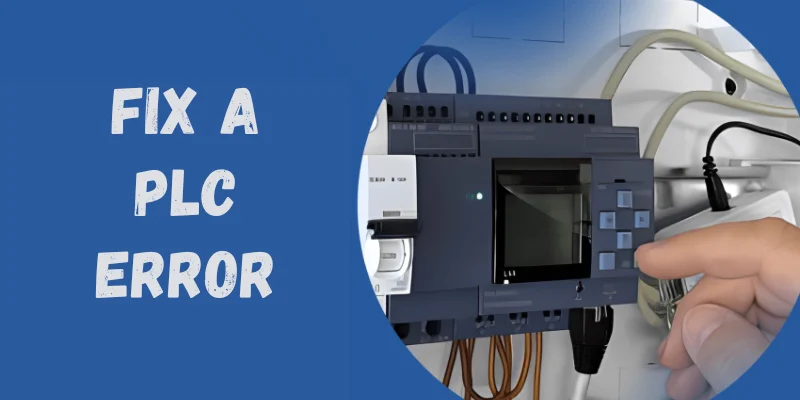
Programmable Logic Controllers (PLCs) are essential in industrial automation, controlling a wide range of applications, from assembly lines to robotic devices. However, like any electronic system, PLCs can encounter errors that disrupt operations and affect productivity. Join our PLC Training in Chennai for expert coaching and placement assistance to advance your career in automation. In this blog, we will discuss how do i fix a PLC error.
Understanding PLC Errors
A PLC error refers to any condition that prevents the PLC from executing its programmed instructions correctly. These errors can arise due to hardware faults, wiring issues, programming bugs, or communication failures with connected devices, such as sensors and actuators.
There are generally two categories of PLC errors:
- Hardware Errors: Related to the power supply, input/output modules, CPU, or other components.
- Software Errors: Caused by incorrect logic, improper configuration, or bugs in the ladder program.
Explore the MATLAB Training in Chennai to gain hands-on experience in data analysis, simulation, and algorithm development.
Common Causes of PLC Errors
Before jumping into a solution, it’s essential to identify the source of the issue. Here are some of the most frequent reasons a PLC might throw an error:
- Power Supply Issues – Voltage drops, faulty power connections, or unstable sources can cause PLCs to reset or malfunction.
- Input/Output (I/O) Failures – Broken or miswired sensors, actuators, or modules may trigger fault codes.
- Program Logic Errors – If the ladder logic isn’t written correctly or doesn’t handle certain conditions, it could halt PLC operation.
- Communication Errors – Network issues or incorrect configuration between the PLC and other devices (e.g., HMIs or SCADA systems) can cause data loss or delays.
- Environmental Conditions – Excessive heat, dust, or moisture can affect PLC performance.
Discover the architecture of a PLC system to understand how industries automate processes with precision and efficiency.
Step-by-Step Guide to Troubleshooting PLCs
Here’s a simplified approach to PLC troubleshooting that technicians and engineers often follow:
Step 1: Check the Error Indicators
Most PLCs have status LEDs on their CPU and I/O modules. These indicators provide quick insight into the system’s state:
- Power LED: Should be solid if the PLC is powered.
- Run/Stop LED: Indicates whether the PLC is executing the program.
- Fault/Error LED: If flashing or red, there’s a fault that needs attention.
FITA Academy offers C C++ Training in Chennai to boost your programming skills and accelerate your career in tech.
Step 2: Review the Error Code
Modern PLCs display error codes through software or on a built-in screen. These codes tell you the exact issue, whether it’s a missing input signal, an I/O fault, or a memory overload.
Use the manufacturer’s documentation or software diagnostic tools to interpret the code.
Step 3: Inspect Connections and Wiring
Loose or broken wires can cause intermittent errors. Visually inspect all input/output wiring, communication cables, and terminal blocks. Use a multimeter to check voltage levels and continuity.
Make sure all devices are properly grounded and securely connected.
Step 4: Examine the Program Logic
If the hardware is intact, the problem might lie in the ladder logic or control program. Open the project file in the PLC programming software and:
- Check for missing or incorrect logic.
- Verify timer and counter settings.
- Test conditional statements and jumps.
Use simulation mode, if available, to validate changes before uploading them to the Programmable Logic Controller (PLC).
Step 5: Reboot and Monitor
After making corrections, reboot the PLC. Monitor the system in run mode to ensure that the error is resolved and that processes function as intended.
Unlock career opportunities with in-demand courses and placement support from a top Training Institute in Chennai.
Best Practices for Preventing PLC Errors
Preventing errors is just as important as fixing them. Here are a few habits that can reduce the chance of PLC failure:
- Routine Maintenance: Regularly clean enclosures, check wiring, and ensure environmental controls.
- Backup Programs: Always save a copy of the PLC program externally in case of system failure.
- Update Software: Use the latest firmware and programming tools recommended by the PLC manufacturer.
- Training: Ensure that your team is trained in PLC troubleshooting and familiar with your system.
PLC errors can disrupt operations, but with a systematic approach, you can effectively diagnose and resolve issues. Understanding the error codes, inspecting hardware connections, and reviewing logic programs are essential steps in troubleshooting PLCs.
Also check: Function of PLC in Automation
